Strategic Analysis of Toyota: Business Growth and Planning Report
VerifiedAdded on 2023/01/13
|19
|4899
|69
Report
AI Summary
This report provides a comprehensive analysis of Toyota's business strategy, examining both its internal and external environments. It begins with an introduction to business strategy and its importance, followed by an analysis of Toyota's macro environment using frameworks like PESTLE and Porter's Five Forces, as well as internal analysis through SWOT and VRIO frameworks. The report delves into strategic planning tools such as the Ansoff growth vector matrix, Porter's Generic Strategies, and Bowman's Strategy Clock. The report covers the strategic context and concludes with key findings and recommendations for Toyota's continued growth and success in the automotive industry. The report also emphasizes on how the company can achieve core competency in the market and how to sustain in the market by innovation and by providing better services.
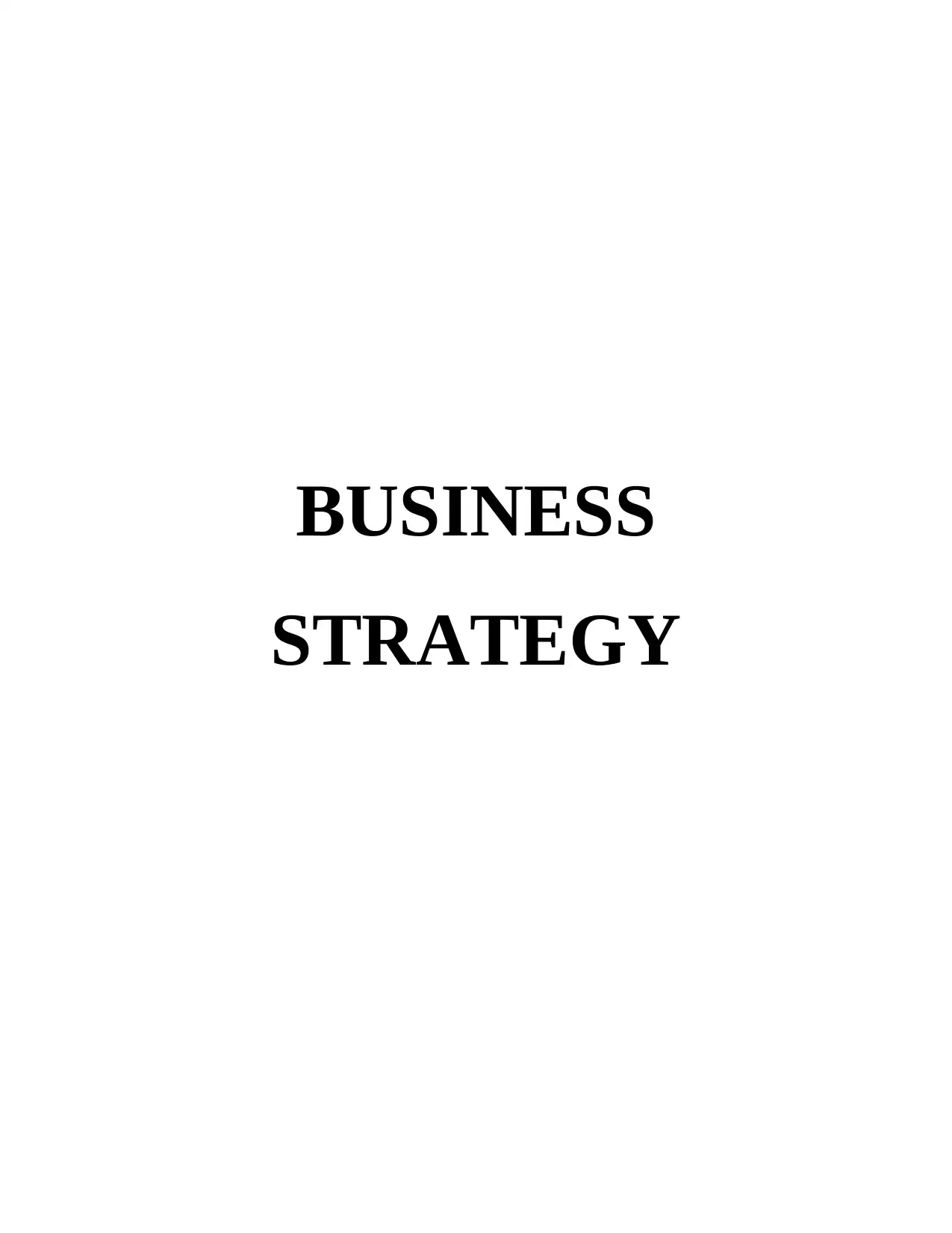
BUSINESS
STRATEGY
STRATEGY
Paraphrase This Document
Need a fresh take? Get an instant paraphrase of this document with our AI Paraphraser
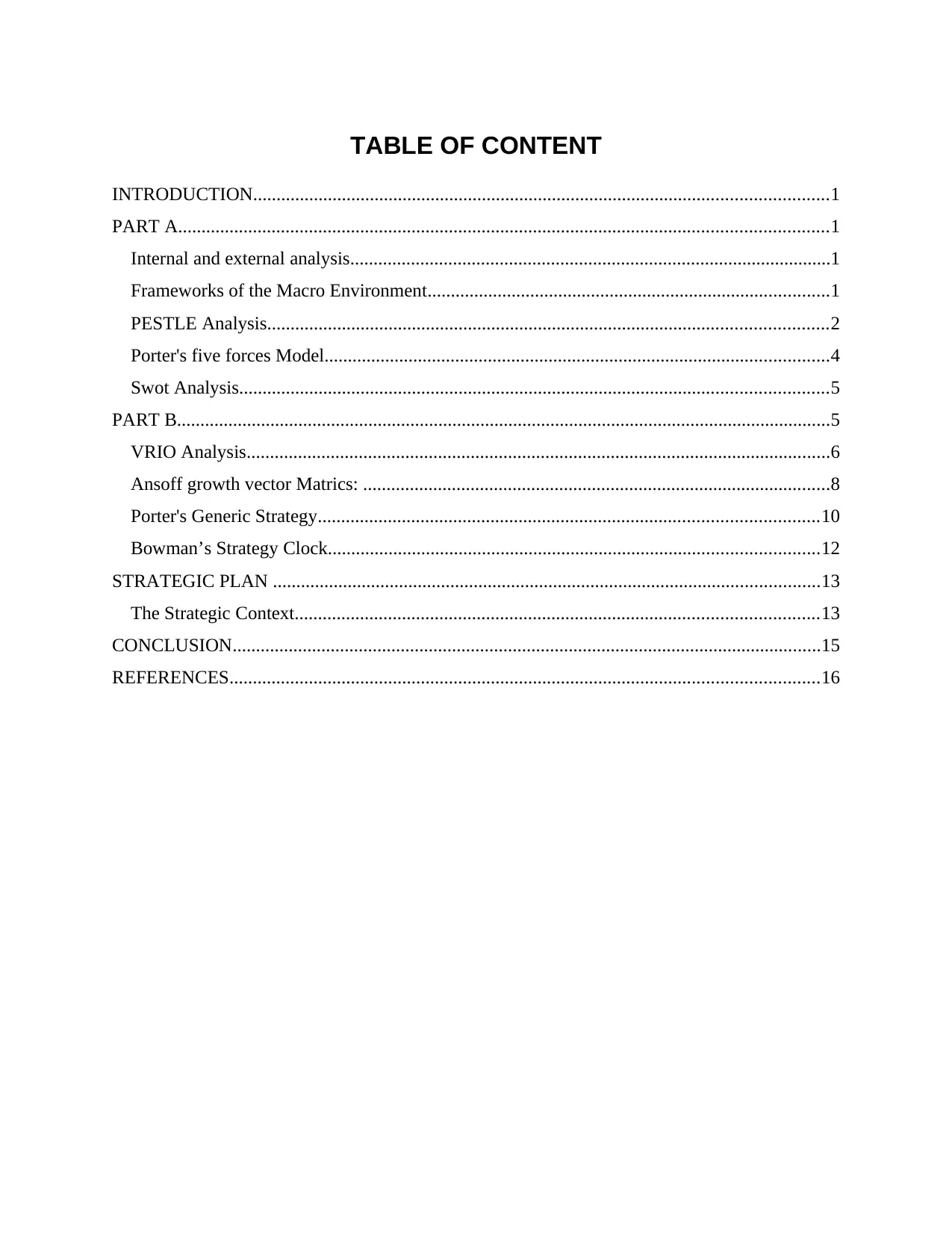
TABLE OF CONTENT
INTRODUCTION...........................................................................................................................1
PART A...........................................................................................................................................1
Internal and external analysis.......................................................................................................1
Frameworks of the Macro Environment......................................................................................1
PESTLE Analysis........................................................................................................................2
Porter's five forces Model............................................................................................................4
Swot Analysis..............................................................................................................................5
PART B............................................................................................................................................5
VRIO Analysis.............................................................................................................................6
Ansoff growth vector Matrics: ....................................................................................................8
Porter's Generic Strategy...........................................................................................................10
Bowman’s Strategy Clock.........................................................................................................12
STRATEGIC PLAN .....................................................................................................................13
The Strategic Context................................................................................................................13
CONCLUSION..............................................................................................................................15
REFERENCES..............................................................................................................................16
INTRODUCTION...........................................................................................................................1
PART A...........................................................................................................................................1
Internal and external analysis.......................................................................................................1
Frameworks of the Macro Environment......................................................................................1
PESTLE Analysis........................................................................................................................2
Porter's five forces Model............................................................................................................4
Swot Analysis..............................................................................................................................5
PART B............................................................................................................................................5
VRIO Analysis.............................................................................................................................6
Ansoff growth vector Matrics: ....................................................................................................8
Porter's Generic Strategy...........................................................................................................10
Bowman’s Strategy Clock.........................................................................................................12
STRATEGIC PLAN .....................................................................................................................13
The Strategic Context................................................................................................................13
CONCLUSION..............................................................................................................................15
REFERENCES..............................................................................................................................16
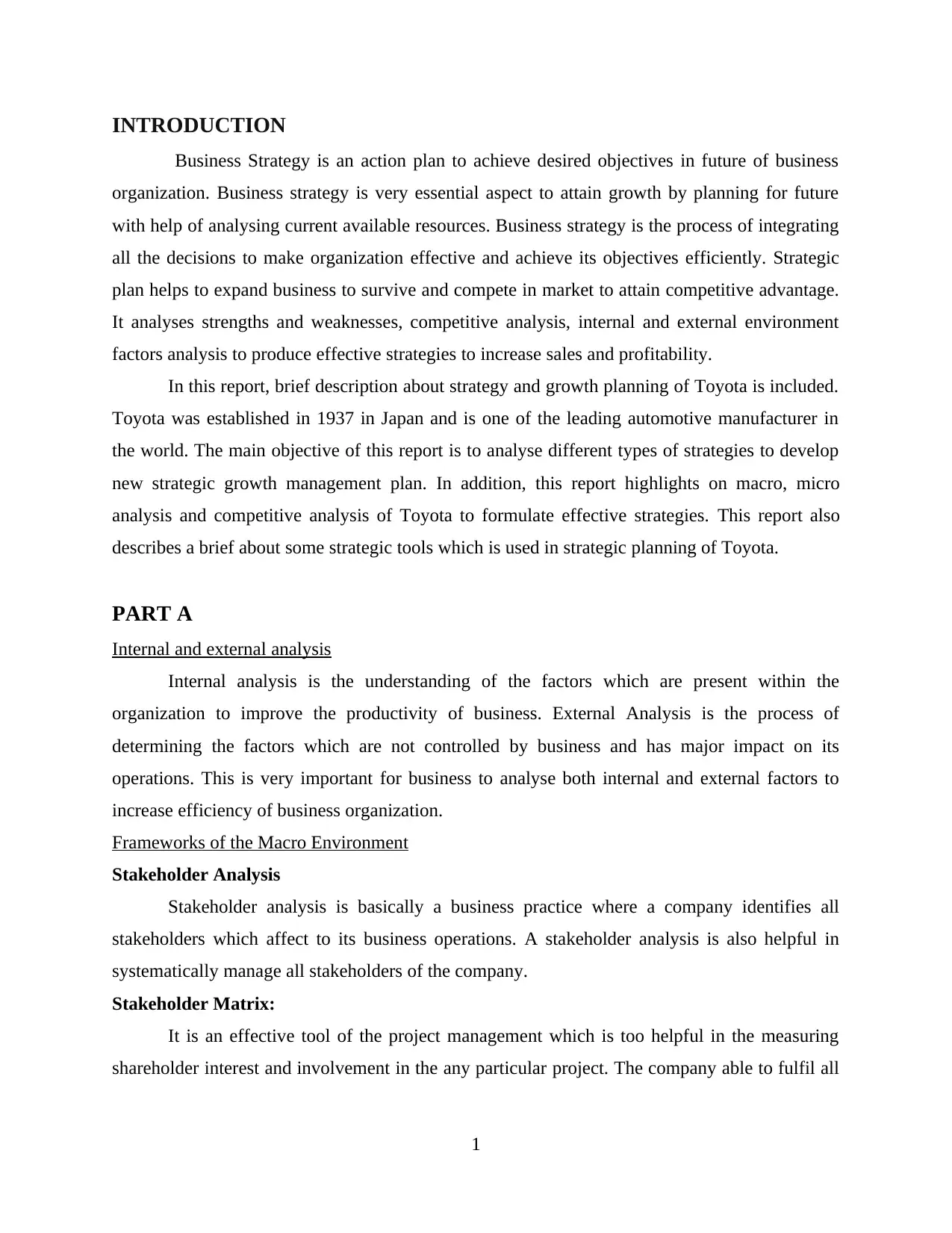
INTRODUCTION
Business Strategy is an action plan to achieve desired objectives in future of business
organization. Business strategy is very essential aspect to attain growth by planning for future
with help of analysing current available resources. Business strategy is the process of integrating
all the decisions to make organization effective and achieve its objectives efficiently. Strategic
plan helps to expand business to survive and compete in market to attain competitive advantage.
It analyses strengths and weaknesses, competitive analysis, internal and external environment
factors analysis to produce effective strategies to increase sales and profitability.
In this report, brief description about strategy and growth planning of Toyota is included.
Toyota was established in 1937 in Japan and is one of the leading automotive manufacturer in
the world. The main objective of this report is to analyse different types of strategies to develop
new strategic growth management plan. In addition, this report highlights on macro, micro
analysis and competitive analysis of Toyota to formulate effective strategies. This report also
describes a brief about some strategic tools which is used in strategic planning of Toyota.
PART A
Internal and external analysis
Internal analysis is the understanding of the factors which are present within the
organization to improve the productivity of business. External Analysis is the process of
determining the factors which are not controlled by business and has major impact on its
operations. This is very important for business to analyse both internal and external factors to
increase efficiency of business organization.
Frameworks of the Macro Environment
Stakeholder Analysis
Stakeholder analysis is basically a business practice where a company identifies all
stakeholders which affect to its business operations. A stakeholder analysis is also helpful in
systematically manage all stakeholders of the company.
Stakeholder Matrix:
It is an effective tool of the project management which is too helpful in the measuring
shareholder interest and involvement in the any particular project. The company able to fulfil all
1
Business Strategy is an action plan to achieve desired objectives in future of business
organization. Business strategy is very essential aspect to attain growth by planning for future
with help of analysing current available resources. Business strategy is the process of integrating
all the decisions to make organization effective and achieve its objectives efficiently. Strategic
plan helps to expand business to survive and compete in market to attain competitive advantage.
It analyses strengths and weaknesses, competitive analysis, internal and external environment
factors analysis to produce effective strategies to increase sales and profitability.
In this report, brief description about strategy and growth planning of Toyota is included.
Toyota was established in 1937 in Japan and is one of the leading automotive manufacturer in
the world. The main objective of this report is to analyse different types of strategies to develop
new strategic growth management plan. In addition, this report highlights on macro, micro
analysis and competitive analysis of Toyota to formulate effective strategies. This report also
describes a brief about some strategic tools which is used in strategic planning of Toyota.
PART A
Internal and external analysis
Internal analysis is the understanding of the factors which are present within the
organization to improve the productivity of business. External Analysis is the process of
determining the factors which are not controlled by business and has major impact on its
operations. This is very important for business to analyse both internal and external factors to
increase efficiency of business organization.
Frameworks of the Macro Environment
Stakeholder Analysis
Stakeholder analysis is basically a business practice where a company identifies all
stakeholders which affect to its business operations. A stakeholder analysis is also helpful in
systematically manage all stakeholders of the company.
Stakeholder Matrix:
It is an effective tool of the project management which is too helpful in the measuring
shareholder interest and involvement in the any particular project. The company able to fulfil all
1
⊘ This is a preview!⊘
Do you want full access?
Subscribe today to unlock all pages.

Trusted by 1+ million students worldwide
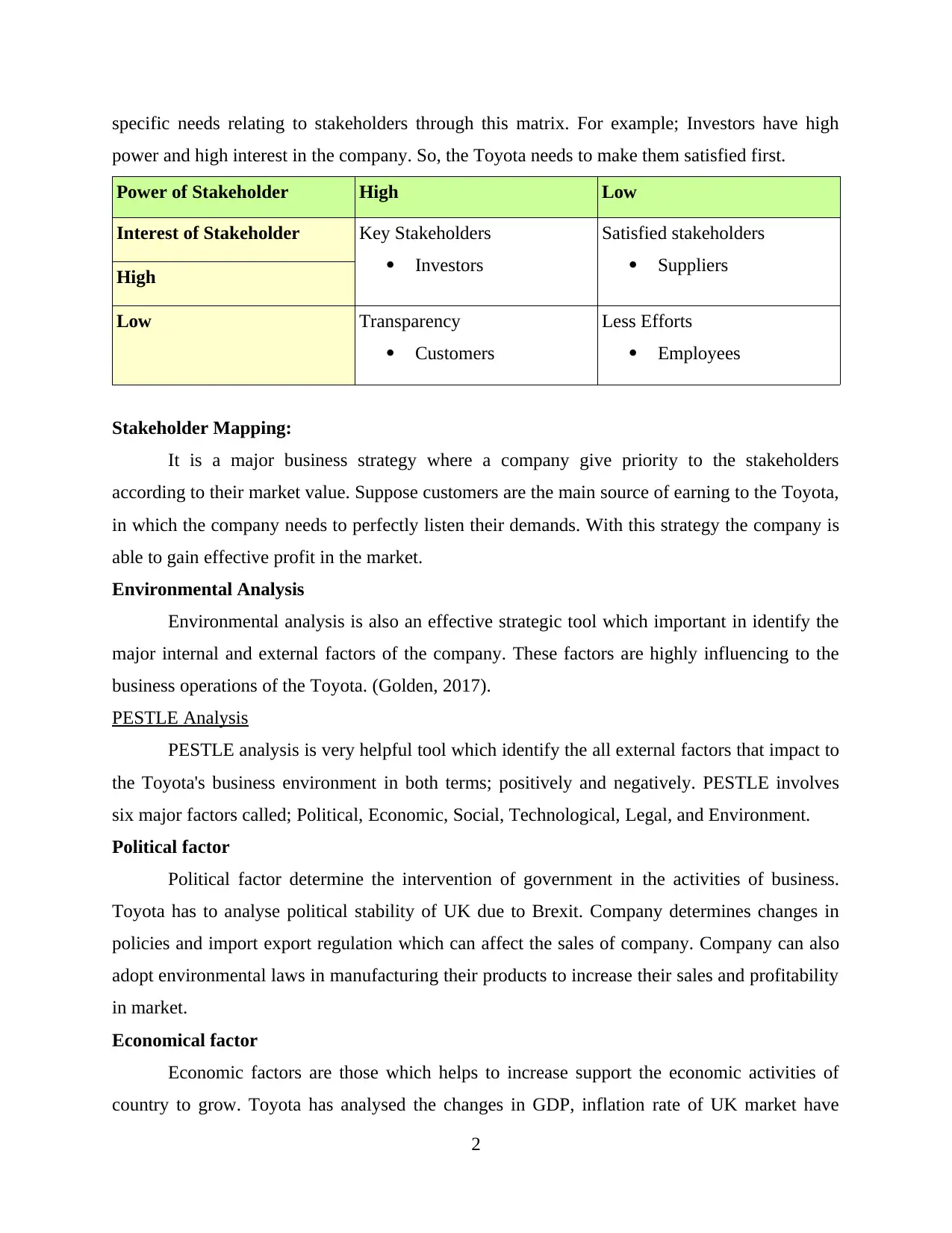
specific needs relating to stakeholders through this matrix. For example; Investors have high
power and high interest in the company. So, the Toyota needs to make them satisfied first.
Power of Stakeholder High Low
Interest of Stakeholder Key Stakeholders
Investors
Satisfied stakeholders
Suppliers
High
Low Transparency
Customers
Less Efforts
Employees
Stakeholder Mapping:
It is a major business strategy where a company give priority to the stakeholders
according to their market value. Suppose customers are the main source of earning to the Toyota,
in which the company needs to perfectly listen their demands. With this strategy the company is
able to gain effective profit in the market.
Environmental Analysis
Environmental analysis is also an effective strategic tool which important in identify the
major internal and external factors of the company. These factors are highly influencing to the
business operations of the Toyota. (Golden, 2017).
PESTLE Analysis
PESTLE analysis is very helpful tool which identify the all external factors that impact to
the Toyota's business environment in both terms; positively and negatively. PESTLE involves
six major factors called; Political, Economic, Social, Technological, Legal, and Environment.
Political factor
Political factor determine the intervention of government in the activities of business.
Toyota has to analyse political stability of UK due to Brexit. Company determines changes in
policies and import export regulation which can affect the sales of company. Company can also
adopt environmental laws in manufacturing their products to increase their sales and profitability
in market.
Economical factor
Economic factors are those which helps to increase support the economic activities of
country to grow. Toyota has analysed the changes in GDP, inflation rate of UK market have
2
power and high interest in the company. So, the Toyota needs to make them satisfied first.
Power of Stakeholder High Low
Interest of Stakeholder Key Stakeholders
Investors
Satisfied stakeholders
Suppliers
High
Low Transparency
Customers
Less Efforts
Employees
Stakeholder Mapping:
It is a major business strategy where a company give priority to the stakeholders
according to their market value. Suppose customers are the main source of earning to the Toyota,
in which the company needs to perfectly listen their demands. With this strategy the company is
able to gain effective profit in the market.
Environmental Analysis
Environmental analysis is also an effective strategic tool which important in identify the
major internal and external factors of the company. These factors are highly influencing to the
business operations of the Toyota. (Golden, 2017).
PESTLE Analysis
PESTLE analysis is very helpful tool which identify the all external factors that impact to
the Toyota's business environment in both terms; positively and negatively. PESTLE involves
six major factors called; Political, Economic, Social, Technological, Legal, and Environment.
Political factor
Political factor determine the intervention of government in the activities of business.
Toyota has to analyse political stability of UK due to Brexit. Company determines changes in
policies and import export regulation which can affect the sales of company. Company can also
adopt environmental laws in manufacturing their products to increase their sales and profitability
in market.
Economical factor
Economic factors are those which helps to increase support the economic activities of
country to grow. Toyota has analysed the changes in GDP, inflation rate of UK market have
2
Paraphrase This Document
Need a fresh take? Get an instant paraphrase of this document with our AI Paraphraser
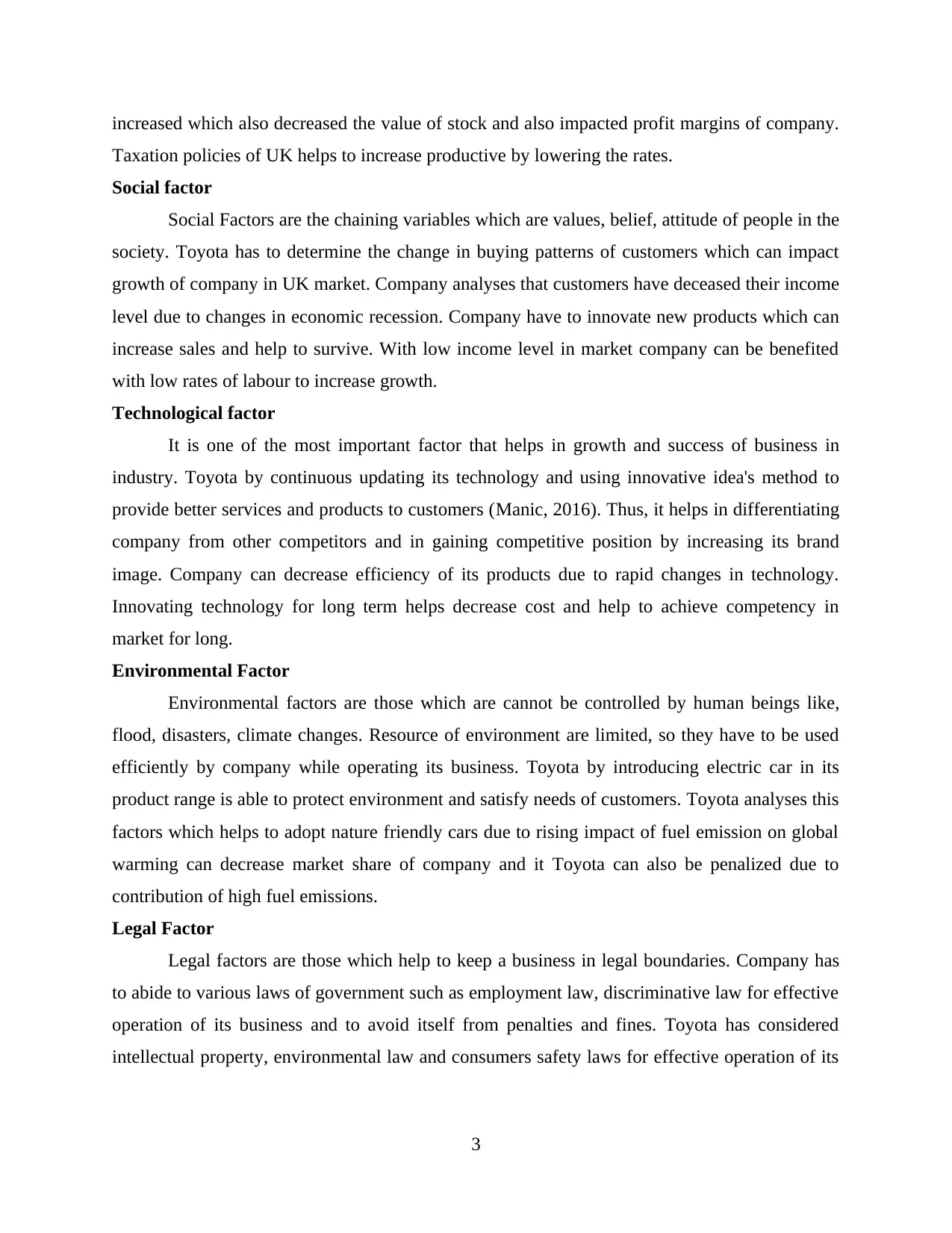
increased which also decreased the value of stock and also impacted profit margins of company.
Taxation policies of UK helps to increase productive by lowering the rates.
Social factor
Social Factors are the chaining variables which are values, belief, attitude of people in the
society. Toyota has to determine the change in buying patterns of customers which can impact
growth of company in UK market. Company analyses that customers have deceased their income
level due to changes in economic recession. Company have to innovate new products which can
increase sales and help to survive. With low income level in market company can be benefited
with low rates of labour to increase growth.
Technological factor
It is one of the most important factor that helps in growth and success of business in
industry. Toyota by continuous updating its technology and using innovative idea's method to
provide better services and products to customers (Manic, 2016). Thus, it helps in differentiating
company from other competitors and in gaining competitive position by increasing its brand
image. Company can decrease efficiency of its products due to rapid changes in technology.
Innovating technology for long term helps decrease cost and help to achieve competency in
market for long.
Environmental Factor
Environmental factors are those which are cannot be controlled by human beings like,
flood, disasters, climate changes. Resource of environment are limited, so they have to be used
efficiently by company while operating its business. Toyota by introducing electric car in its
product range is able to protect environment and satisfy needs of customers. Toyota analyses this
factors which helps to adopt nature friendly cars due to rising impact of fuel emission on global
warming can decrease market share of company and it Toyota can also be penalized due to
contribution of high fuel emissions.
Legal Factor
Legal factors are those which help to keep a business in legal boundaries. Company has
to abide to various laws of government such as employment law, discriminative law for effective
operation of its business and to avoid itself from penalties and fines. Toyota has considered
intellectual property, environmental law and consumers safety laws for effective operation of its
3
Taxation policies of UK helps to increase productive by lowering the rates.
Social factor
Social Factors are the chaining variables which are values, belief, attitude of people in the
society. Toyota has to determine the change in buying patterns of customers which can impact
growth of company in UK market. Company analyses that customers have deceased their income
level due to changes in economic recession. Company have to innovate new products which can
increase sales and help to survive. With low income level in market company can be benefited
with low rates of labour to increase growth.
Technological factor
It is one of the most important factor that helps in growth and success of business in
industry. Toyota by continuous updating its technology and using innovative idea's method to
provide better services and products to customers (Manic, 2016). Thus, it helps in differentiating
company from other competitors and in gaining competitive position by increasing its brand
image. Company can decrease efficiency of its products due to rapid changes in technology.
Innovating technology for long term helps decrease cost and help to achieve competency in
market for long.
Environmental Factor
Environmental factors are those which are cannot be controlled by human beings like,
flood, disasters, climate changes. Resource of environment are limited, so they have to be used
efficiently by company while operating its business. Toyota by introducing electric car in its
product range is able to protect environment and satisfy needs of customers. Toyota analyses this
factors which helps to adopt nature friendly cars due to rising impact of fuel emission on global
warming can decrease market share of company and it Toyota can also be penalized due to
contribution of high fuel emissions.
Legal Factor
Legal factors are those which help to keep a business in legal boundaries. Company has
to abide to various laws of government such as employment law, discriminative law for effective
operation of its business and to avoid itself from penalties and fines. Toyota has considered
intellectual property, environmental law and consumers safety laws for effective operation of its
3
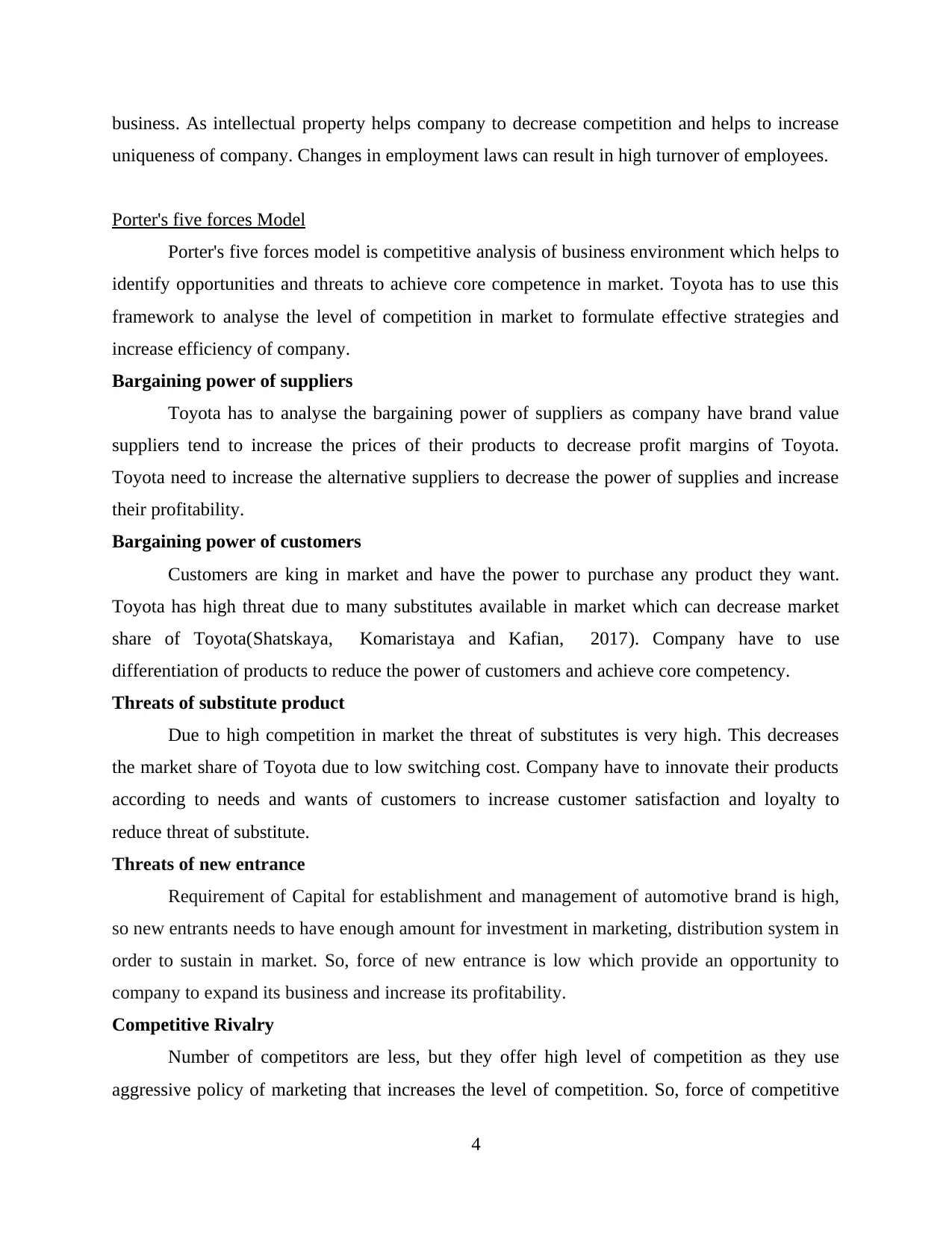
business. As intellectual property helps company to decrease competition and helps to increase
uniqueness of company. Changes in employment laws can result in high turnover of employees.
Porter's five forces Model
Porter's five forces model is competitive analysis of business environment which helps to
identify opportunities and threats to achieve core competence in market. Toyota has to use this
framework to analyse the level of competition in market to formulate effective strategies and
increase efficiency of company.
Bargaining power of suppliers
Toyota has to analyse the bargaining power of suppliers as company have brand value
suppliers tend to increase the prices of their products to decrease profit margins of Toyota.
Toyota need to increase the alternative suppliers to decrease the power of supplies and increase
their profitability.
Bargaining power of customers
Customers are king in market and have the power to purchase any product they want.
Toyota has high threat due to many substitutes available in market which can decrease market
share of Toyota(Shatskaya, Komaristaya and Kafian, 2017). Company have to use
differentiation of products to reduce the power of customers and achieve core competency.
Threats of substitute product
Due to high competition in market the threat of substitutes is very high. This decreases
the market share of Toyota due to low switching cost. Company have to innovate their products
according to needs and wants of customers to increase customer satisfaction and loyalty to
reduce threat of substitute.
Threats of new entrance
Requirement of Capital for establishment and management of automotive brand is high,
so new entrants needs to have enough amount for investment in marketing, distribution system in
order to sustain in market. So, force of new entrance is low which provide an opportunity to
company to expand its business and increase its profitability.
Competitive Rivalry
Number of competitors are less, but they offer high level of competition as they use
aggressive policy of marketing that increases the level of competition. So, force of competitive
4
uniqueness of company. Changes in employment laws can result in high turnover of employees.
Porter's five forces Model
Porter's five forces model is competitive analysis of business environment which helps to
identify opportunities and threats to achieve core competence in market. Toyota has to use this
framework to analyse the level of competition in market to formulate effective strategies and
increase efficiency of company.
Bargaining power of suppliers
Toyota has to analyse the bargaining power of suppliers as company have brand value
suppliers tend to increase the prices of their products to decrease profit margins of Toyota.
Toyota need to increase the alternative suppliers to decrease the power of supplies and increase
their profitability.
Bargaining power of customers
Customers are king in market and have the power to purchase any product they want.
Toyota has high threat due to many substitutes available in market which can decrease market
share of Toyota(Shatskaya, Komaristaya and Kafian, 2017). Company have to use
differentiation of products to reduce the power of customers and achieve core competency.
Threats of substitute product
Due to high competition in market the threat of substitutes is very high. This decreases
the market share of Toyota due to low switching cost. Company have to innovate their products
according to needs and wants of customers to increase customer satisfaction and loyalty to
reduce threat of substitute.
Threats of new entrance
Requirement of Capital for establishment and management of automotive brand is high,
so new entrants needs to have enough amount for investment in marketing, distribution system in
order to sustain in market. So, force of new entrance is low which provide an opportunity to
company to expand its business and increase its profitability.
Competitive Rivalry
Number of competitors are less, but they offer high level of competition as they use
aggressive policy of marketing that increases the level of competition. So, force of competitive
4
⊘ This is a preview!⊘
Do you want full access?
Subscribe today to unlock all pages.

Trusted by 1+ million students worldwide
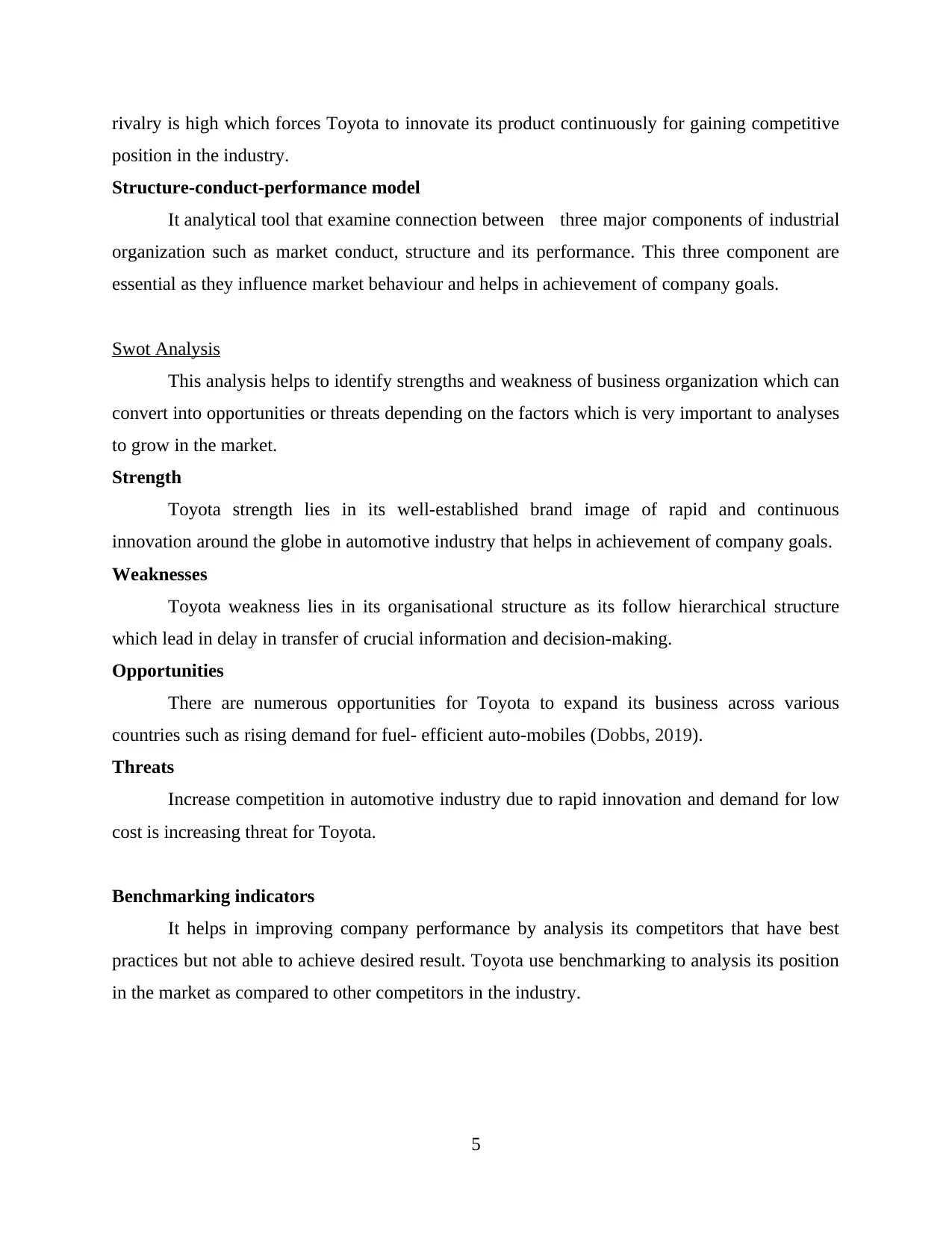
rivalry is high which forces Toyota to innovate its product continuously for gaining competitive
position in the industry.
Structure-conduct-performance model
It analytical tool that examine connection between three major components of industrial
organization such as market conduct, structure and its performance. This three component are
essential as they influence market behaviour and helps in achievement of company goals.
Swot Analysis
This analysis helps to identify strengths and weakness of business organization which can
convert into opportunities or threats depending on the factors which is very important to analyses
to grow in the market.
Strength
Toyota strength lies in its well-established brand image of rapid and continuous
innovation around the globe in automotive industry that helps in achievement of company goals.
Weaknesses
Toyota weakness lies in its organisational structure as its follow hierarchical structure
which lead in delay in transfer of crucial information and decision-making.
Opportunities
There are numerous opportunities for Toyota to expand its business across various
countries such as rising demand for fuel- efficient auto-mobiles (Dobbs, 2019).
Threats
Increase competition in automotive industry due to rapid innovation and demand for low
cost is increasing threat for Toyota.
Benchmarking indicators
It helps in improving company performance by analysis its competitors that have best
practices but not able to achieve desired result. Toyota use benchmarking to analysis its position
in the market as compared to other competitors in the industry.
5
position in the industry.
Structure-conduct-performance model
It analytical tool that examine connection between three major components of industrial
organization such as market conduct, structure and its performance. This three component are
essential as they influence market behaviour and helps in achievement of company goals.
Swot Analysis
This analysis helps to identify strengths and weakness of business organization which can
convert into opportunities or threats depending on the factors which is very important to analyses
to grow in the market.
Strength
Toyota strength lies in its well-established brand image of rapid and continuous
innovation around the globe in automotive industry that helps in achievement of company goals.
Weaknesses
Toyota weakness lies in its organisational structure as its follow hierarchical structure
which lead in delay in transfer of crucial information and decision-making.
Opportunities
There are numerous opportunities for Toyota to expand its business across various
countries such as rising demand for fuel- efficient auto-mobiles (Dobbs, 2019).
Threats
Increase competition in automotive industry due to rapid innovation and demand for low
cost is increasing threat for Toyota.
Benchmarking indicators
It helps in improving company performance by analysis its competitors that have best
practices but not able to achieve desired result. Toyota use benchmarking to analysis its position
in the market as compared to other competitors in the industry.
5
Paraphrase This Document
Need a fresh take? Get an instant paraphrase of this document with our AI Paraphraser
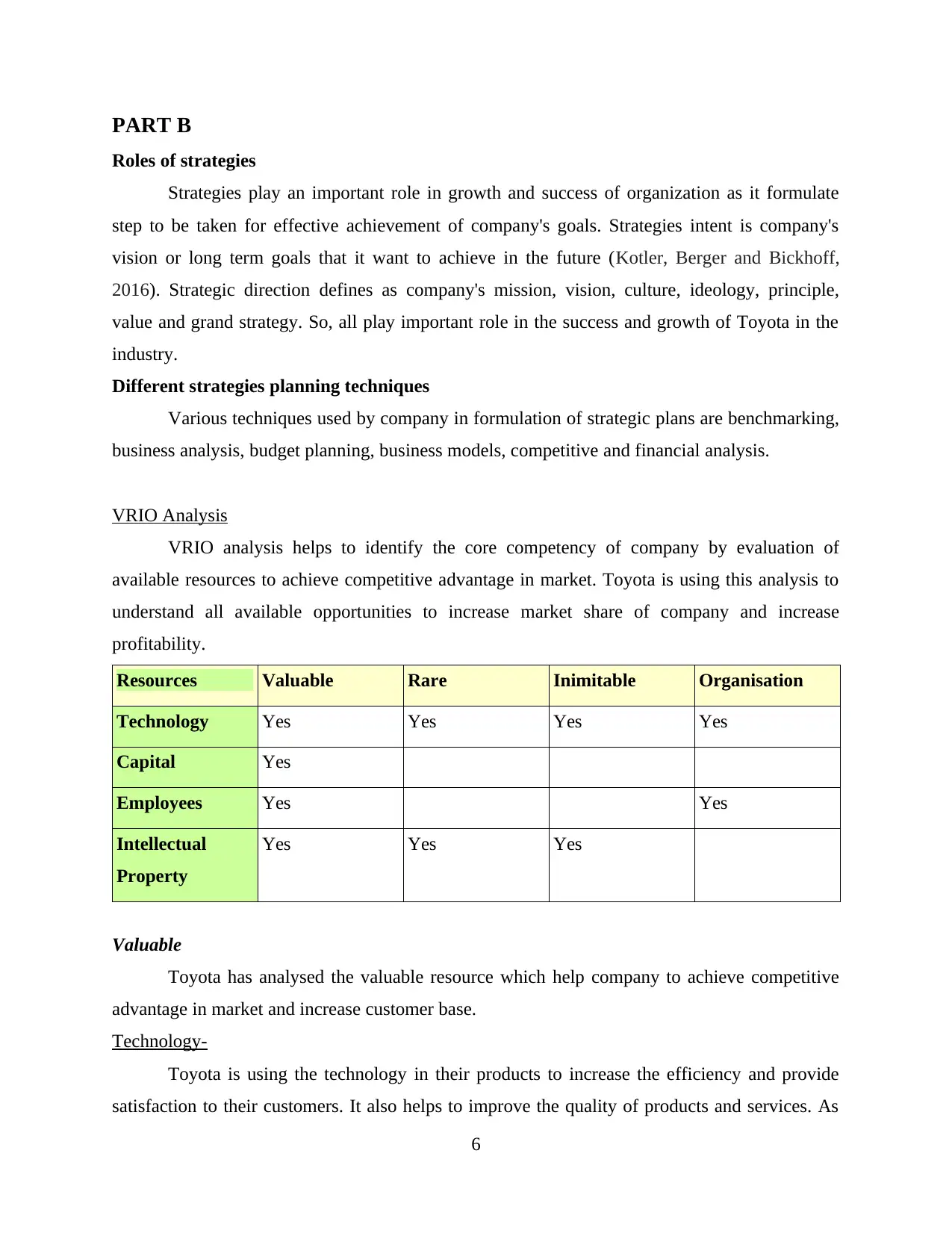
PART B
Roles of strategies
Strategies play an important role in growth and success of organization as it formulate
step to be taken for effective achievement of company's goals. Strategies intent is company's
vision or long term goals that it want to achieve in the future (Kotler, Berger and Bickhoff,
2016). Strategic direction defines as company's mission, vision, culture, ideology, principle,
value and grand strategy. So, all play important role in the success and growth of Toyota in the
industry.
Different strategies planning techniques
Various techniques used by company in formulation of strategic plans are benchmarking,
business analysis, budget planning, business models, competitive and financial analysis.
VRIO Analysis
VRIO analysis helps to identify the core competency of company by evaluation of
available resources to achieve competitive advantage in market. Toyota is using this analysis to
understand all available opportunities to increase market share of company and increase
profitability.
Resources Valuable Rare Inimitable Organisation
Technology Yes Yes Yes Yes
Capital Yes
Employees Yes Yes
Intellectual
Property
Yes Yes Yes
Valuable
Toyota has analysed the valuable resource which help company to achieve competitive
advantage in market and increase customer base.
Technology-
Toyota is using the technology in their products to increase the efficiency and provide
satisfaction to their customers. It also helps to improve the quality of products and services. As
6
Roles of strategies
Strategies play an important role in growth and success of organization as it formulate
step to be taken for effective achievement of company's goals. Strategies intent is company's
vision or long term goals that it want to achieve in the future (Kotler, Berger and Bickhoff,
2016). Strategic direction defines as company's mission, vision, culture, ideology, principle,
value and grand strategy. So, all play important role in the success and growth of Toyota in the
industry.
Different strategies planning techniques
Various techniques used by company in formulation of strategic plans are benchmarking,
business analysis, budget planning, business models, competitive and financial analysis.
VRIO Analysis
VRIO analysis helps to identify the core competency of company by evaluation of
available resources to achieve competitive advantage in market. Toyota is using this analysis to
understand all available opportunities to increase market share of company and increase
profitability.
Resources Valuable Rare Inimitable Organisation
Technology Yes Yes Yes Yes
Capital Yes
Employees Yes Yes
Intellectual
Property
Yes Yes Yes
Valuable
Toyota has analysed the valuable resource which help company to achieve competitive
advantage in market and increase customer base.
Technology-
Toyota is using the technology in their products to increase the efficiency and provide
satisfaction to their customers. It also helps to improve the quality of products and services. As
6
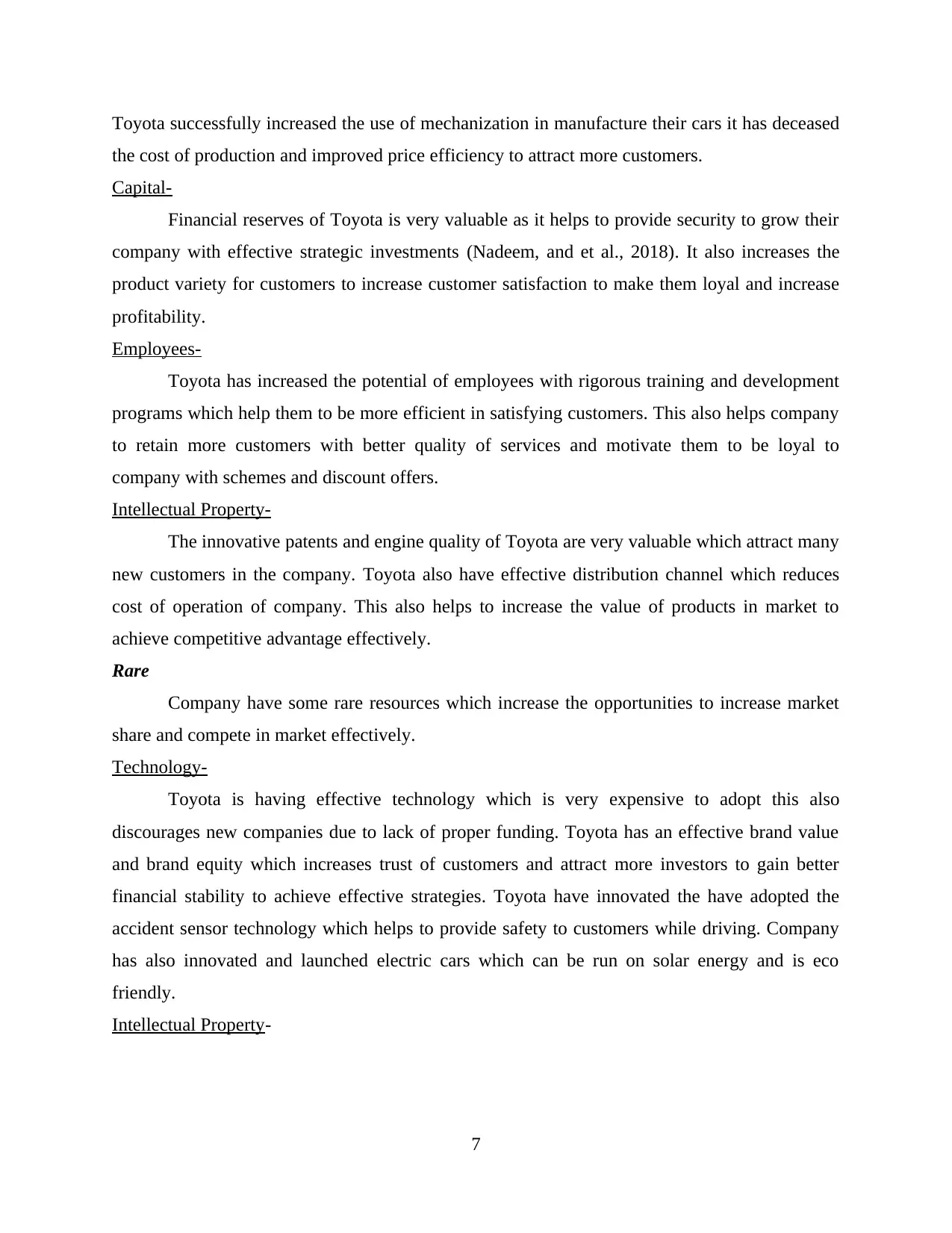
Toyota successfully increased the use of mechanization in manufacture their cars it has deceased
the cost of production and improved price efficiency to attract more customers.
Capital-
Financial reserves of Toyota is very valuable as it helps to provide security to grow their
company with effective strategic investments (Nadeem, and et al., 2018). It also increases the
product variety for customers to increase customer satisfaction to make them loyal and increase
profitability.
Employees-
Toyota has increased the potential of employees with rigorous training and development
programs which help them to be more efficient in satisfying customers. This also helps company
to retain more customers with better quality of services and motivate them to be loyal to
company with schemes and discount offers.
Intellectual Property-
The innovative patents and engine quality of Toyota are very valuable which attract many
new customers in the company. Toyota also have effective distribution channel which reduces
cost of operation of company. This also helps to increase the value of products in market to
achieve competitive advantage effectively.
Rare
Company have some rare resources which increase the opportunities to increase market
share and compete in market effectively.
Technology-
Toyota is having effective technology which is very expensive to adopt this also
discourages new companies due to lack of proper funding. Toyota has an effective brand value
and brand equity which increases trust of customers and attract more investors to gain better
financial stability to achieve effective strategies. Toyota have innovated the have adopted the
accident sensor technology which helps to provide safety to customers while driving. Company
has also innovated and launched electric cars which can be run on solar energy and is eco
friendly.
Intellectual Property-
7
the cost of production and improved price efficiency to attract more customers.
Capital-
Financial reserves of Toyota is very valuable as it helps to provide security to grow their
company with effective strategic investments (Nadeem, and et al., 2018). It also increases the
product variety for customers to increase customer satisfaction to make them loyal and increase
profitability.
Employees-
Toyota has increased the potential of employees with rigorous training and development
programs which help them to be more efficient in satisfying customers. This also helps company
to retain more customers with better quality of services and motivate them to be loyal to
company with schemes and discount offers.
Intellectual Property-
The innovative patents and engine quality of Toyota are very valuable which attract many
new customers in the company. Toyota also have effective distribution channel which reduces
cost of operation of company. This also helps to increase the value of products in market to
achieve competitive advantage effectively.
Rare
Company have some rare resources which increase the opportunities to increase market
share and compete in market effectively.
Technology-
Toyota is having effective technology which is very expensive to adopt this also
discourages new companies due to lack of proper funding. Toyota has an effective brand value
and brand equity which increases trust of customers and attract more investors to gain better
financial stability to achieve effective strategies. Toyota have innovated the have adopted the
accident sensor technology which helps to provide safety to customers while driving. Company
has also innovated and launched electric cars which can be run on solar energy and is eco
friendly.
Intellectual Property-
7
⊘ This is a preview!⊘
Do you want full access?
Subscribe today to unlock all pages.

Trusted by 1+ million students worldwide
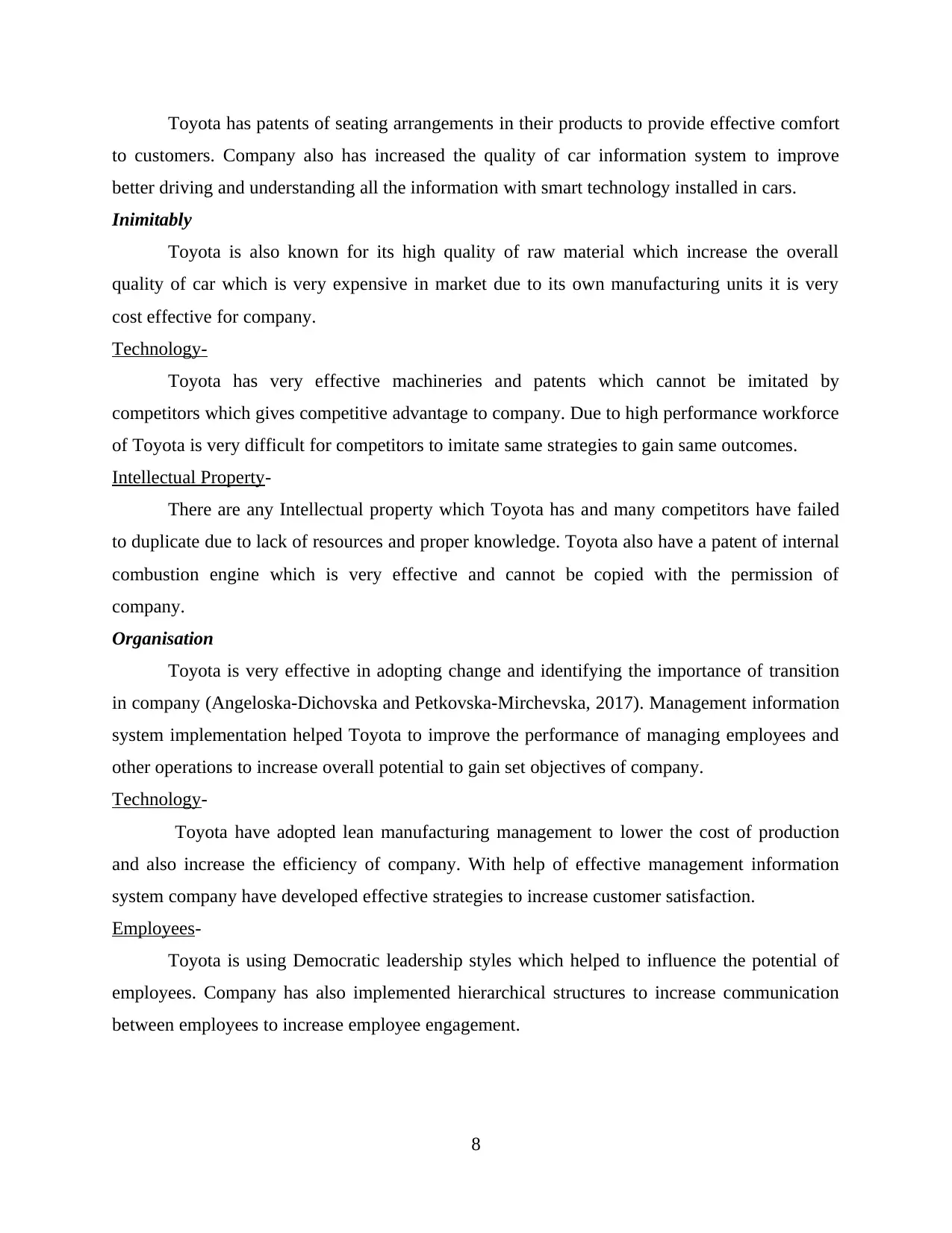
Toyota has patents of seating arrangements in their products to provide effective comfort
to customers. Company also has increased the quality of car information system to improve
better driving and understanding all the information with smart technology installed in cars.
Inimitably
Toyota is also known for its high quality of raw material which increase the overall
quality of car which is very expensive in market due to its own manufacturing units it is very
cost effective for company.
Technology-
Toyota has very effective machineries and patents which cannot be imitated by
competitors which gives competitive advantage to company. Due to high performance workforce
of Toyota is very difficult for competitors to imitate same strategies to gain same outcomes.
Intellectual Property-
There are any Intellectual property which Toyota has and many competitors have failed
to duplicate due to lack of resources and proper knowledge. Toyota also have a patent of internal
combustion engine which is very effective and cannot be copied with the permission of
company.
Organisation
Toyota is very effective in adopting change and identifying the importance of transition
in company (Angeloska-Dichovska and Petkovska-Mirchevska, 2017). Management information
system implementation helped Toyota to improve the performance of managing employees and
other operations to increase overall potential to gain set objectives of company.
Technology-
Toyota have adopted lean manufacturing management to lower the cost of production
and also increase the efficiency of company. With help of effective management information
system company have developed effective strategies to increase customer satisfaction.
Employees-
Toyota is using Democratic leadership styles which helped to influence the potential of
employees. Company has also implemented hierarchical structures to increase communication
between employees to increase employee engagement.
8
to customers. Company also has increased the quality of car information system to improve
better driving and understanding all the information with smart technology installed in cars.
Inimitably
Toyota is also known for its high quality of raw material which increase the overall
quality of car which is very expensive in market due to its own manufacturing units it is very
cost effective for company.
Technology-
Toyota has very effective machineries and patents which cannot be imitated by
competitors which gives competitive advantage to company. Due to high performance workforce
of Toyota is very difficult for competitors to imitate same strategies to gain same outcomes.
Intellectual Property-
There are any Intellectual property which Toyota has and many competitors have failed
to duplicate due to lack of resources and proper knowledge. Toyota also have a patent of internal
combustion engine which is very effective and cannot be copied with the permission of
company.
Organisation
Toyota is very effective in adopting change and identifying the importance of transition
in company (Angeloska-Dichovska and Petkovska-Mirchevska, 2017). Management information
system implementation helped Toyota to improve the performance of managing employees and
other operations to increase overall potential to gain set objectives of company.
Technology-
Toyota have adopted lean manufacturing management to lower the cost of production
and also increase the efficiency of company. With help of effective management information
system company have developed effective strategies to increase customer satisfaction.
Employees-
Toyota is using Democratic leadership styles which helped to influence the potential of
employees. Company has also implemented hierarchical structures to increase communication
between employees to increase employee engagement.
8
Paraphrase This Document
Need a fresh take? Get an instant paraphrase of this document with our AI Paraphraser
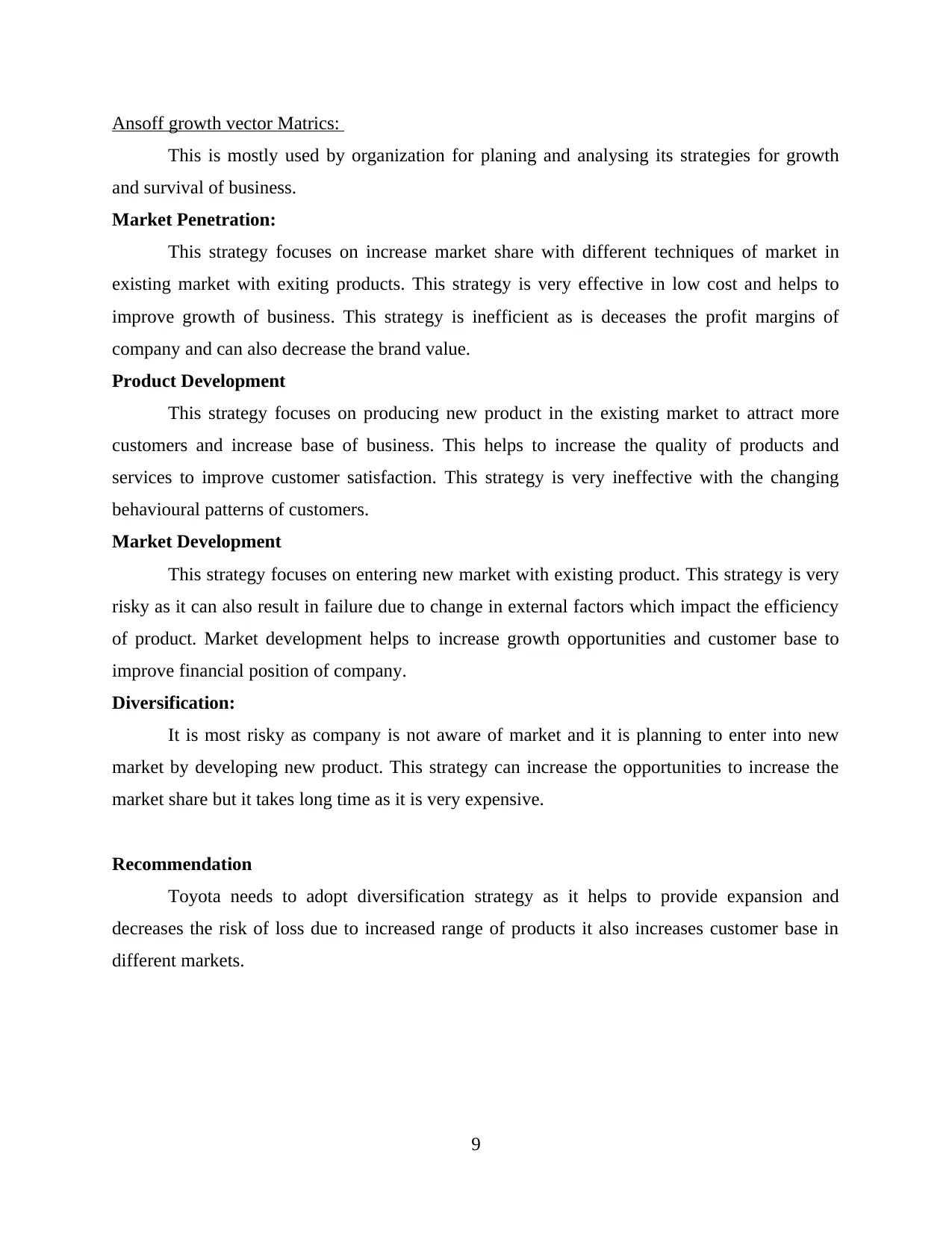
Ansoff growth vector Matrics:
This is mostly used by organization for planing and analysing its strategies for growth
and survival of business.
Market Penetration:
This strategy focuses on increase market share with different techniques of market in
existing market with exiting products. This strategy is very effective in low cost and helps to
improve growth of business. This strategy is inefficient as is deceases the profit margins of
company and can also decrease the brand value.
Product Development
This strategy focuses on producing new product in the existing market to attract more
customers and increase base of business. This helps to increase the quality of products and
services to improve customer satisfaction. This strategy is very ineffective with the changing
behavioural patterns of customers.
Market Development
This strategy focuses on entering new market with existing product. This strategy is very
risky as it can also result in failure due to change in external factors which impact the efficiency
of product. Market development helps to increase growth opportunities and customer base to
improve financial position of company.
Diversification:
It is most risky as company is not aware of market and it is planning to enter into new
market by developing new product. This strategy can increase the opportunities to increase the
market share but it takes long time as it is very expensive.
Recommendation
Toyota needs to adopt diversification strategy as it helps to provide expansion and
decreases the risk of loss due to increased range of products it also increases customer base in
different markets.
9
This is mostly used by organization for planing and analysing its strategies for growth
and survival of business.
Market Penetration:
This strategy focuses on increase market share with different techniques of market in
existing market with exiting products. This strategy is very effective in low cost and helps to
improve growth of business. This strategy is inefficient as is deceases the profit margins of
company and can also decrease the brand value.
Product Development
This strategy focuses on producing new product in the existing market to attract more
customers and increase base of business. This helps to increase the quality of products and
services to improve customer satisfaction. This strategy is very ineffective with the changing
behavioural patterns of customers.
Market Development
This strategy focuses on entering new market with existing product. This strategy is very
risky as it can also result in failure due to change in external factors which impact the efficiency
of product. Market development helps to increase growth opportunities and customer base to
improve financial position of company.
Diversification:
It is most risky as company is not aware of market and it is planning to enter into new
market by developing new product. This strategy can increase the opportunities to increase the
market share but it takes long time as it is very expensive.
Recommendation
Toyota needs to adopt diversification strategy as it helps to provide expansion and
decreases the risk of loss due to increased range of products it also increases customer base in
different markets.
9
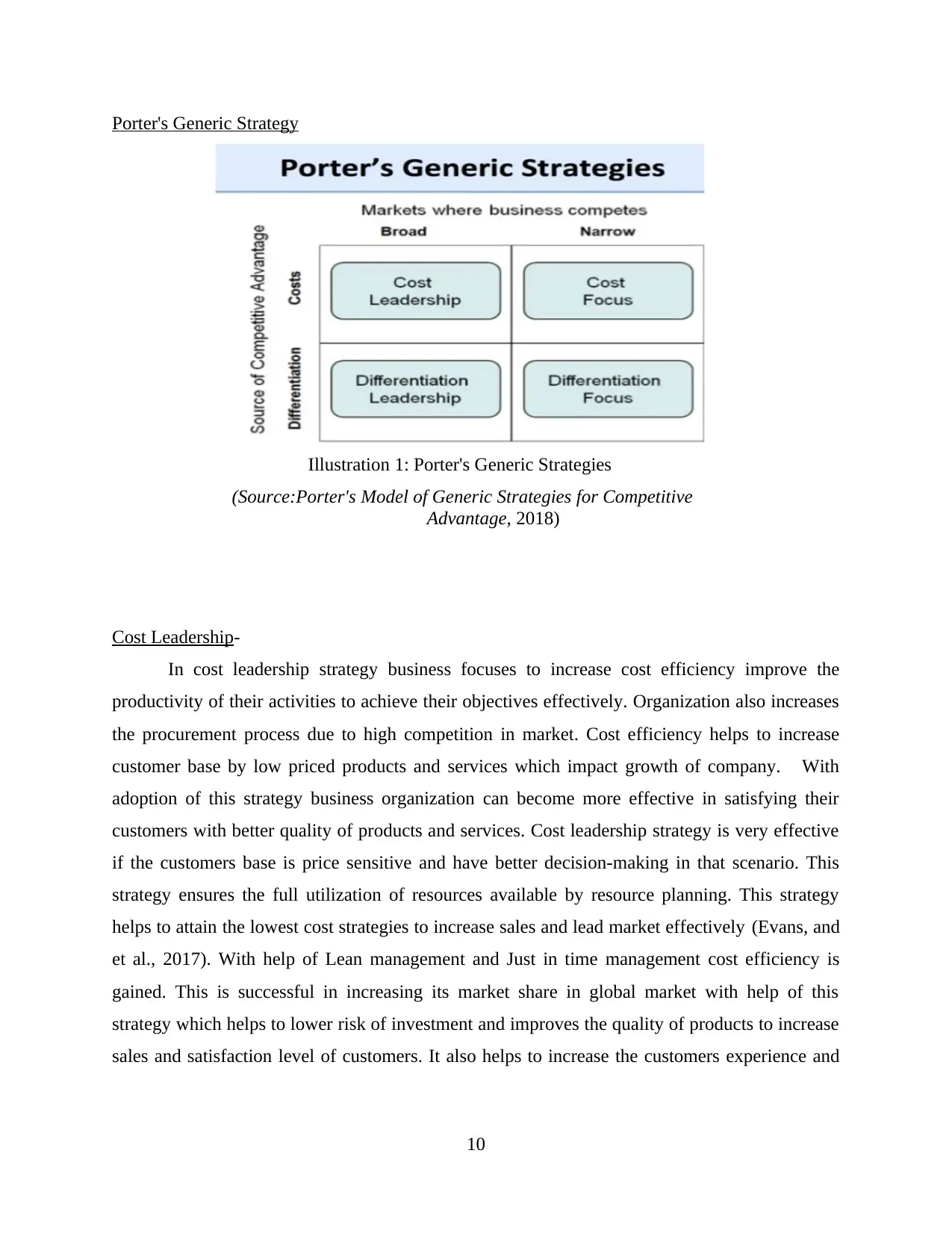
Porter's Generic Strategy
Cost Leadership-
In cost leadership strategy business focuses to increase cost efficiency improve the
productivity of their activities to achieve their objectives effectively. Organization also increases
the procurement process due to high competition in market. Cost efficiency helps to increase
customer base by low priced products and services which impact growth of company. With
adoption of this strategy business organization can become more effective in satisfying their
customers with better quality of products and services. Cost leadership strategy is very effective
if the customers base is price sensitive and have better decision-making in that scenario. This
strategy ensures the full utilization of resources available by resource planning. This strategy
helps to attain the lowest cost strategies to increase sales and lead market effectively (Evans, and
et al., 2017). With help of Lean management and Just in time management cost efficiency is
gained. This is successful in increasing its market share in global market with help of this
strategy which helps to lower risk of investment and improves the quality of products to increase
sales and satisfaction level of customers. It also helps to increase the customers experience and
10
Illustration 1: Porter's Generic Strategies
(Source:Porter's Model of Generic Strategies for Competitive
Advantage, 2018)
Cost Leadership-
In cost leadership strategy business focuses to increase cost efficiency improve the
productivity of their activities to achieve their objectives effectively. Organization also increases
the procurement process due to high competition in market. Cost efficiency helps to increase
customer base by low priced products and services which impact growth of company. With
adoption of this strategy business organization can become more effective in satisfying their
customers with better quality of products and services. Cost leadership strategy is very effective
if the customers base is price sensitive and have better decision-making in that scenario. This
strategy ensures the full utilization of resources available by resource planning. This strategy
helps to attain the lowest cost strategies to increase sales and lead market effectively (Evans, and
et al., 2017). With help of Lean management and Just in time management cost efficiency is
gained. This is successful in increasing its market share in global market with help of this
strategy which helps to lower risk of investment and improves the quality of products to increase
sales and satisfaction level of customers. It also helps to increase the customers experience and
10
Illustration 1: Porter's Generic Strategies
(Source:Porter's Model of Generic Strategies for Competitive
Advantage, 2018)
⊘ This is a preview!⊘
Do you want full access?
Subscribe today to unlock all pages.

Trusted by 1+ million students worldwide
1 out of 19
Related Documents
Your All-in-One AI-Powered Toolkit for Academic Success.
+13062052269
info@desklib.com
Available 24*7 on WhatsApp / Email
![[object Object]](/_next/static/media/star-bottom.7253800d.svg)
Unlock your academic potential
Copyright © 2020–2025 A2Z Services. All Rights Reserved. Developed and managed by ZUCOL.




